 An allergy is an adverse reaction that the body has to a particular food or substance in the environment. Allergic reactions can cause anaphylaxis. Most substances that cause allergies are not harmful and have no effect on people who are not allergic. An allergen is any substance that triggers an allergic reaction.
An allergy is an adverse reaction that the body has to a particular food or substance in the environment. Allergic reactions can cause anaphylaxis. Most substances that cause allergies are not harmful and have no effect on people who are not allergic. An allergen is any substance that triggers an allergic reaction.
Allergies
The most common allergies include peanuts, other nuts, eggs and cow’s milk. An allergy develops when the body’s immune system reacts to an allergen as though it is a threat, like an infection. It produces antibodies to fight off the allergen, in a reaction called an immune response. The next time that person comes into contact with the allergen, the body “remembers” the previous exposure and produces more of the antibodies. This causes the release of histamines in the body which causes an allergic reaction.
Common allergic disorders include asthma, eczema and hay fever. Symptoms of an allergy can include sneezing, wheezing, coughing and skin rashes. The nature of the symptoms, however, depends on how you came into contact with the allergen. For example, you may experience problems with your airways if you breathe in pollen.
Anaphylactic Reactions
Anaphylactic reactions are those that cause a serious reaction that then affects the respiratory system. These can be life-threatening and should be treated very seriously. They can be very dangerous because if the throat closes, then the person will not be able to breathe. This will mean that not enough oxygen will reach the brain. The allergen could be ingested by eating it, inhaled, absorbed through the skin or injected like a bee sting. Allergic reactions are not just an anaphylactic type reaction. There are different levels of reactions which include allergies, sensitivity and intolerance.
Sensitivity, Intolerance and Anaphylaxis
Sensitivity is the exaggeration of a normal side effect produced after coming into contact with a substance. For example, the caffeine in a cup of coffee may cause extreme symptoms, such as palpitations and trembles. Usually, caffeine would only have this effect when taken in much larger doses. Therefore, sensitivity can be seen as the body producing more of an effect to a substance than the average person.
Intolerance is where a substance causes unpleasant symptoms such as diarrhoea. This can be for a number of reasons but does not involve the immune system. Typical intolerances could be gluten and lactose. People with an intolerance to certain foods can normally eat a small amount without having any problems. On the other hand, people with a food allergy will have a bad reaction no matter the volume of the allergen.
Where someone has an intolerance or sensitivity, treatment is often to remove the source and let nature take its course. Where there is an anaphylactic reaction to an allergen, auto-injectors are often used to inject a pre-set dose of adrenaline. You inject the adrenaline into the muscle of the body, normally in the top third of the outer thigh. What this does is help to reduce the reaction caused by the allergen.
Signs and Symptoms of Anaphylaxis
- Itchy skin
- A raised, red skin rash
- Swollen eyes, lips, hands and feet
- Feeling lightheaded or faint
- Narrowing of the airways which can cause wheezing and breathing difficulties
- Breathing difficulties can lead to a blue tinge on extremities
- Abdominal pain, nausea and vomiting
- Unconsciousness
No matter what, you should always treat anaphylaxis as a medical emergency. If you suspect that you or somebody else is experiencing symptoms of anaphylaxis, you should immediately call for an ambulance.
Learn more about Anaphylaxis and its treatment. Video online training at www.proanaphylaxis.co.uk.
For more information on training courses, visit our “Courses” page which also includes our First Responder and First Person on Scene (FPOS) Courses.

